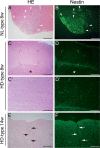Identification of a novel set of genes reflecting different in vivo invasive patterns of human GBM cells
- PMID: 22901239
- PMCID: PMC3502598
- DOI: 10.1186/1471-2407-12-358
Identification of a novel set of genes reflecting different in vivo invasive patterns of human GBM cells
Abstract
Background: Most patients affected by Glioblastoma multiforme (GBM, grade IV glioma) experience a recurrence of the disease because of the spreading of tumor cells beyond surgical boundaries. Unveiling mechanisms causing this process is a logic goal to impair the killing capacity of GBM cells by molecular targeting.We noticed that our long-term GBM cultures, established from different patients, may display two categories/types of growth behavior in an orthotopic xenograft model: expansion of the tumor mass and formation of tumor branches/nodules (nodular like, NL-type) or highly diffuse single tumor cell infiltration (HD-type).
Methods: We determined by DNA microarrays the gene expression profiles of three NL-type and three HD-type long-term GBM cultures. Subsequently, individual genes with different expression levels between the two groups were identified using Significance Analysis of Microarrays (SAM). Real time RT-PCR, immunofluorescence and immunoblot analyses, were performed for a selected subgroup of regulated gene products to confirm the results obtained by the expression analysis.
Results: Here, we report the identification of a set of 34 differentially expressed genes in the two types of GBM cultures. Twenty-three of these genes encode for proteins localized to the plasma membrane and 9 of these for proteins are involved in the process of cell adhesion.
Conclusions: This study suggests the participation in the diffuse infiltrative/invasive process of GBM cells within the CNS of a novel set of genes coding for membrane-associated proteins, which should be thus susceptible to an inhibition strategy by specific targeting.Massimiliano Monticone and Antonio Daga contributed equally to this work.
Figures






Similar articles
-
MicroRNA-377 inhibited proliferation and invasion of human glioblastoma cells by directly targeting specificity protein 1.Neuro Oncol. 2014 Nov;16(11):1510-22. doi: 10.1093/neuonc/nou111. Epub 2014 Jun 20. Neuro Oncol. 2014. PMID: 24951112 Free PMC article.
-
Maintenance of primary tumor phenotype and genotype in glioblastoma stem cells.Neuro Oncol. 2012 Feb;14(2):132-44. doi: 10.1093/neuonc/nor195. Epub 2011 Nov 7. Neuro Oncol. 2012. PMID: 22067563 Free PMC article.
-
Gene expression profile of glioblastoma multiforme invasive phenotype points to new therapeutic targets.Neoplasia. 2005 Jan;7(1):7-16. doi: 10.1593/neo.04535. Neoplasia. 2005. PMID: 15720813 Free PMC article.
-
KCa3.1 channels are involved in the infiltrative behavior of glioblastoma in vivo.Cell Death Dis. 2013 Aug 15;4(8):e773. doi: 10.1038/cddis.2013.279. Cell Death Dis. 2013. PMID: 23949222 Free PMC article.
-
Combined expressional analysis, bioinformatics and targeted proteomics identify new potential therapeutic targets in glioblastoma stem cells.Oncotarget. 2015 Sep 22;6(28):26192-215. doi: 10.18632/oncotarget.4613. Oncotarget. 2015. PMID: 26295306 Free PMC article.
Cited by
-
Reduced FHIT expression is associated with mismatch repair deficient and high CpG island methylator phenotype colorectal cancer.J Histochem Cytochem. 2013 Sep;61(9):627-38. doi: 10.1369/0022155413497367. Epub 2013 Jun 24. J Histochem Cytochem. 2013. PMID: 23797051 Free PMC article.
-
Association between epidermal growth factor receptor amplification and ADP-ribosylation factor 1 methylation in human glioblastoma.Cell Oncol (Dordr). 2017 Aug;40(4):389-399. doi: 10.1007/s13402-017-0329-5. Epub 2017 Jun 19. Cell Oncol (Dordr). 2017. PMID: 28631186
-
Inhibition of Chloride Intracellular Channel 1 (CLIC1) as Biguanide Class-Effect to Impair Human Glioblastoma Stem Cell Viability.Front Pharmacol. 2018 Aug 21;9:899. doi: 10.3389/fphar.2018.00899. eCollection 2018. Front Pharmacol. 2018. PMID: 30186163 Free PMC article.
-
Whole-exome sequencing, EGFR amplification and infiltration patterns in human glioblastoma.Am J Cancer Res. 2021 Nov 15;11(11):5543-5558. eCollection 2021. Am J Cancer Res. 2021. PMID: 34873478 Free PMC article.
-
The NFL-TBS.40-63 anti-glioblastoma peptide disrupts microtubule and mitochondrial networks in the T98G glioma cell line.PLoS One. 2014 Jun 4;9(6):e98473. doi: 10.1371/journal.pone.0098473. eCollection 2014. PLoS One. 2014. PMID: 24896268 Free PMC article.
References
Publication types
MeSH terms
LinkOut - more resources
Full Text Sources
Medical
Molecular Biology Databases

